#pixenite
Text
How to Use A/B Testing in Email Marketing?
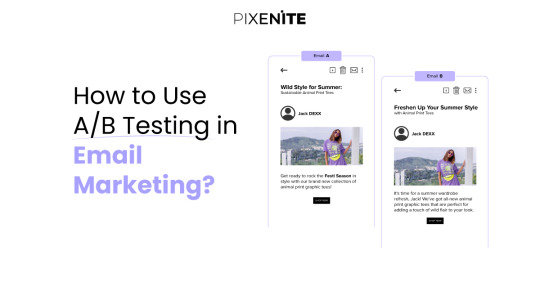
Ever wonder why some emails make you hit "open" right away, while others get buried in the abyss of your inbox? It's all about creating emails that grab your attention and make you want to click. But how do you know what kind of email will resonate with your audience? That's where A/B testing comes in, and it's way easier than it sounds!
Imagine this: You have two best friends who are twins, except for one thing – their outfits. A/B testing is like dressing your friends differently and sending them to a party. You want to see which outfit gets more compliments (think "opens" and "clicks" in the email world).
Here's the scoop on A/B testing:
You create two almost-identical emails, but with one tiny difference you want to test (like the subject line).
These "twins" (called variations) get sent to random people on your email list.
You see which email gets more action (opens, clicks) based on your goals.
The winning email (the twin with more high fives) becomes your champion sent to everyone else!
Why is A/B testing awesome for email marketing agencies?
Think of it like having a secret weapon! You can ditch guesswork and use real data to make your emails super effective. This means:
More people opening your emails: Catchy subject lines, clear calls to action (CTAs), and interesting content – A/B testing helps you find what makes people want to read on.
More people clicking what you want them to: Whether it's visiting a website, buying something, or signing up, A/B testing helps you craft emails that drive results.
More bang for your buck: With emails that work harder, not just harder, your email marketing efforts become more cost-effective – who doesn't love that?
So, what can you test in your emails? Lots of things!
Subject Lines: Is it short and sweet or a question that begs to be answered? Test different styles to see which grabs attention.
Who's Sending the Email: Should it be your company name, a friendly team member, or something creative? Test it out!
Sneak Peek Text: This short preview shows up next to the subject line in some inboxes. Test if a clear preview that explains what the email is about helps people open it.
Email Design: Think clear fonts, easy-to-read layouts, and eye-catching images. Test different designs to see what makes your email shine.
Click Here!: This is your CTA, the button that tells people what to do next. Test different colors, wording, and placement to see what gets clicked the most.
Send Time: Maybe mornings are best, or maybe evenings work better. Test different times to see when your audience is most receptive.
Testing Tips to Remember:
Start Small: Don't overwhelm your audience (or yourself!). Test one thing at a time to see its real impact.
Pick a Goal: What do you want your email to achieve? More opens? Clicks? Define your goal to guide your testing.
Just the Right Amount of People: Don't test on everyone. Choose a good sample size to get reliable results. Most email marketing tools can help you with this.
Check the Results!: Once the test is done, see which email variation won. But don't stop there! Use this info to make your future emails even better.
Be Patient: Building a winning A/B testing strategy takes time. Don't get discouraged if the first test doesn't blow your mind. Keep testing and learning to unlock your email marketing magic!
Conclusion
A/B testing isn't a magic trick, but it's a powerful tool in any email marketing agency arsenal. By strategically testing different elements of your emails, Pixenite can help you create campaigns that resonate with your audience and drive real results.
Remember, even small improvements in email performance lead to big gains for your clients. With Pixenite, the leading email marketing agency, you can unlock the full potential of A/B testing and refine your strategies to deliver exceptional value. Start testing today and watch your email marketing soar!
FAQs
Q: How many people should I include in my A/B test?
The ideal sample size depends on your email list size. A/B testing tools often provide recommendations based on your subscriber count.
Q: When can I expect to see reliable results from my A/B test?
This depends on your email volume and open rates. Generally, aim for enough data to ensure statistically significant results.
Q. What if the results are inconclusive?
If the data doesn't show a clear winner, it might be due to an insufficient sample size or testing period. Consider extending the test or increasing the sample size.
Q. Can I A/B test multiple elements at once?
While tempting, testing too many variables can make it difficult to isolate the impact of each change. It's best to stick to one element per test.
Article Source : https://www.linkedin.com/pulse/how-use-ab-testing-email-marketing-pixeniteofficial-fraif
#ABTesting#EmailMarketing#DigitalMarketing#EmailCampaigns#MarketingStrategy#EmailOptimization#pixenite
0 notes
Text
How to Use Negative Keywords to Improve PPC?
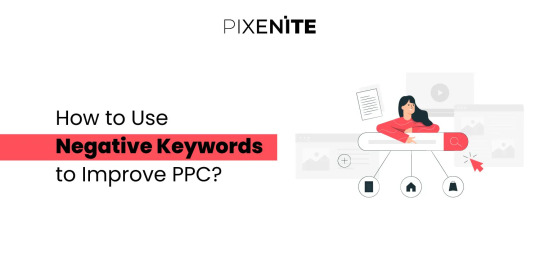
Are you running PPC (pay-per-click) marketing campaigns and feeling like you’re throwing money down a drain? You might be getting a lot of clicks on your ads, but are they turning into actual customers? If not, you’re not alone. Many PPC campaigns suffer from irrelevant clicks, which can eat away at your budget and leave you feeling frustrated.
This is where negative keywords come in. They act as silent heroes in the world of PPC marketing, helping you refine your targeting and ensure your ads are shown only to the people most likely to be interested in what you offer.
Pixenite, a leading PPC marketing agency, understands the importance of using negative keywords to improve the efficiency of your campaigns. In this blog, we’ll explore the magic of negative keywords and how you can leverage them to boost the efficiency of your PPC campaigns. Whether you’re a seasoned PPC pro or just starting out, this guide will equip you with the knowledge to get the most out of your advertising dollars.
What Are Negative Keywords?
Imagine negative keywords as filters for your PPC campaigns. Instead of targeting every single search term related to your product or service, you can use negative keywords to block your ads from appearing for irrelevant searches. This helps you reach a more qualified audience, people who are genuinely interested in what you have to offer and more likely to convert into paying customers.
For example, let’s say you sell high-end running shoes. You might target the keyword “running shoes,” but you wouldn’t want your ad to show up for searches like “free running shoes” or “cheap running shoes.” By adding these terms as negative keywords, you can ensure your ads are only seen by people actively looking to buy quality running shoes.
Benefits of Using Negative Keywords
Here’s why negative keywords are a must-have in your PPC marketing toolbox:
Reduced Costs: By stopping irrelevant clicks, you save money on your PPC budget. You’re only paying for clicks that have the potential to convert into sales.
Improved Click-Through Rate (CTR): When your ads are shown to a more targeted audience, you’re more likely to get clicks from people genuinely interested in your product or service. This leads to a higher CTR, which is a key performance indicator (KPI) for PPC campaigns.
Enhanced Quality Score: Quality Score is a ranking assigned by PPC platforms (like Google Ads) that reflects the relevance of your ads, keywords, and landing pages. A good quality score can lead to lower costs and better ad placement. Using negative keywords helps improve your Quality Score by ensuring your ads are highly relevant to the search queries triggering them.
Better Conversion Rates: By attracting a more qualified audience, you’re more likely to see an increase in conversions (sales, signups, etc.). This is the ultimate goal of any PPC campaign, and negative keywords play a crucial role in achieving it.
How to Find Negative Keywords
There are several ways to identify negative keywords for your PPC campaigns:
Search Term Reports: Most PPC platforms provide search term reports that show you all the search queries that triggered your ads. Analyze these reports to identify irrelevant search terms and add them as negative keywords.
Competitor Research: Spy on your competitors’ PPC campaigns to see what keywords they’re using (and not using). You might discover negative keyword opportunities you hadn’t considered before.
Brainstorming: Put yourself in the shoes of someone who wouldn’t be interested in your product or service. What search terms might they use? Make sure to include those terms in your list.
Industry Knowledge: Think about common misconceptions or irrelevant searches related to your industry. These can be valuable negative keywords.
Using Negative Keywords Effectively
Here are some tips for using negative keywords effectively in your PPC campaigns:
Start Broad, Refine Gradually: Begin with a broad list of negative keywords and then refine it over time as you analyze your campaign data.
Match Types Matter: Negative keywords come with different match types, just like regular keywords. Broad match blocks searches containing the entire negative keyword phrase, while exact match only blocks searches with the exact phrase. Choose the appropriate match type based on your specific needs.
Monitor and Update Regularly: PPC landscapes are constantly evolving. Regularly review your search term reports and update your negative keyword list to ensure it continues to be effective.
Organize by Campaign/Ad Group: For complex campaigns, categorize your negative keywords by campaign or ad group for better organization.
Conclusion
Stop wasting ad money on clicks that go nowhere! Negative keywords are like blockers for your ads, ensuring they only reach people likely to buy. They save you money, get more relevant clicks, and boost sales. Partner with a PPC pro like Pixenite to unleash the power of negative keywords and watch your ads thrive!
FAQs
Q. Can I use negative keywords to block my competitors’ brand names?
In most cases, PPC platforms won’t allow you to use your competitor’s brand names as negative keywords. This is to prevent unfair competition.
Q. Will using too many negative keywords hurt my campaign performance?
It’s important to strike a balance. While negative keywords are powerful, using too many can restrict your reach and limit the potential for relevant traffic. Start with a targeted list and gradually add more based on your campaign data.
Q. How often should I review my negative keywords?
There’s no one-size-fits-all answer, but it’s a good practice to review your search term reports and negative keyword list at least once a month. This allows you to identify new irrelevant terms and adjust your strategy accordingly.
Q. Can I use negative keywords with different ad groups in the same campaign?
Absolutely! You can have different negative keyword lists for different ad groups within the same campaign. This allows for more granular control over which searches trigger your ads for each specific offering.
Q. Are there any negative keyword tools available?
Yes, there are several PPC management tools that offer negative keyword suggestion features. These tools can analyze your campaign data and suggest relevant negative keywords to add.
Article Source : https://medium.com/@pixenite/how-to-use-negative-keywords-to-improve-ppc-2653f2a3ec52
0 notes
Text
Improving Your Amazon Brand with Content Agencies

Selling on Amazon is like having a shop in a giant mall, but with millions of other shops! It's amazing, but how do you get people to notice yours? This is where an Amazon content creation agency comes in.
Why Content Matters on Amazon
Imagine amazing product descriptions, cool pictures, and even short videos explaining what you sell. That's what great content is! Here's why it's important:
More Shoppers See You: Think of keywords like secret words people type to find things. Content with the right keywords helps your products show up higher in searches.
Tell Your Brand Story: Content lets you explain what makes your brand special and why people should choose you.
More Sales: Clear descriptions and cool visuals help convince shoppers your product is what they need.
Happy Customers: Good content builds trust. People see you care and are more likely to buy from you.
How a Content Creation agency Can Help
Creating this awesome content can be tricky, so here's how an Amazon content creation agency can help:
Plan It Out: They'll work with you to understand your brand and who you're trying to reach. Then they'll create a content plan just for you.
Keyword Magic: They'll find the secret words shoppers use and put them in your descriptions so people can find you easily.
Words that Sell: They'll write descriptions that grab attention and explain why your product is amazing.
Picture Perfect: They'll take stunning photos and even videos to show off your products in the best way possible.
More Than Descriptions: They can create special content like A+ Content on Amazon to tell your brand story with even more detail.
They Do Even More!
The best companies, like Pixenite, offer extra help:
Competitor Checkup: We'll see what your competition is doing and help you do it better.
Ads that Work: We can manage your Amazon ads to make sure they reach the right people.
Review Power: We can help you get more good reviews and handle any not-so-great ones.
Conclusion
The Amazon marketplace presents a vast opportunity for brands to connect with millions of potential customers. By partnering with a reputable Amazon content creation agency like Pixenite, you can elevate your brand presence, increase sales, and build lasting customer relationships.
FAQ’s
Q. How much does it cost?
Prices depend on what you need done, but most agencies offer different plans to fit your budget.
Q. What are the key benefits of working with an Amazon content creation agency?
The benefits are numerous! Increased sales, improved brand visibility, enhanced customer trust, and a competitive edge within the Amazon landscape are just a few.
Q. How do I choose the right Amazon content creation agency for my brand?
Look for an agency with a proven track record of success in the Amazon space. Consider their experience in your specific industry and inquire about the specific services they offer. Don't hesitate to ask for references and case studies to gauge their expertise.
Q. Can I do it myself?
Sure, but it can be tough. An agency can take care of everything so you can focus on running your business.
Article Source : https://www.linkedin.com/pulse/improving-your-amazon-brand-content-agencies-pixeniteofficial-9shkf/
0 notes
Text
How Can You Measure Social Media ROI?

In the current digital landscape, social media holds significant power for businesses of any scale. But with so much time and effort poured into crafting engaging content and running campaigns, a crucial question arises: how do you actually measure the impact of your social media efforts? Here at Pixenite, we understand the importance of demonstrating the value you bring. That's why we're here to guide you through the world of Social Media ROI (Return on Investment) and equip you with the tools to prove your social media success.
What is Social Media ROI?
Simply put, Social Media ROI is a way to measure the return you get on your investment in social media. It's like a scorecard that tells you how much value your social media activities are generating for your business. Here's the basic formula:
ROI=(Total Revenue - Total Investment) / Total Investment x 100
Why is Social Media ROI Important?
Imagine trying to convince your boss to give you more money for social media without any proof it's working. Not ideal, right? Social Media ROI helps you:
Show the value: Prove your social media efforts are bringing in new customers or making people aware of your brand.
Track progress: See what kind of engagement your posts are getting and if they're driving traffic to your website.
Get better results: Use the data to figure out what's working and what's not, so you can improve your social media game.
Setting Smart Goals
Before you dive into numbers, think about what you want to achieve with social media. Do you want more people to know your brand? Get more website visitors? Sell more products? Whatever it is, make your goals SMART:
Specific: Exactly what do you want? (e.g., increase brand awareness by 20%)
Measurable: How will you track your progress? (e.g., by the number of followers you gain)
Achievable: Set realistic goals you can reach with your resources.
Relevant: How does social media fit into your overall business plan?
Time-bound: Give yourself a deadline to reach your goals (e.g., 3 months).
What to Track: Keeping Score on Social Media
Now, let's look at some things to track depending on your goals:
Brand Awareness:
Reach: The Count of Individuals Who Viewed Your Content.
Impressions: The Overall Count of Times Your Content Was Displayed.
Follower Growth: The increase in your audience over time.
Brand Mentions: How often people are talking about your brand online.
Engagement:
Likes, Comments, and Shares: How much interaction are your posts generating?
Click-Through Rate (CTR): The Percentage of Individuals Who Click on a Link in Your Post.
Lead Generation and Sales:
Website Traffic: How much traffic are your social media posts driving to your website?
Lead Generation: The number of leads captured through social media (e.g., signups for a newsletter).
Conversion Rate: The proportion of website visitors who become paying customers.
Tools to Track Your Social Media ROI
Many social media platforms include analytics tools that offer insights into your performance. Additionally, there are numerous social media management platforms that offer comprehensive reporting features.
Calculating Your Social Media ROI
Once you have your data, it's time to calculate your ROI. Here's how:
Define the value of a social media "win" For example, if a lead generated through social media is worth $100 to your business, assign that value as your "gain" from social media.
Track your social media costs. This includes paid advertising spend, staff time, and any tools you use.
Plug your numbers into the ROI formula.
Understanding Your ROI: It's Not Just About the Numbers
While numbers are important, social media ROI goes beyond just a single metric. Consider the qualitative aspects as well. Social media helps build brand loyalty, fosters customer relationships, and strengthens your brand image. These intangible benefits can be just as valuable as the hard numbers.
Conclusion:
By following these tips and consistently measuring your Social Media ROI, you can ensure your social media efforts are driving real business results. Keep in mind, social media success is a long-term journey, not a quick race. Be patient, stay focused, and keep optimizing your strategy to maximize your return on investment.
At Pixenite, we understand the complexities of social media marketing. We can help you develop a data-driven strategy, create engaging content, and track your results to maximize your ROI. Get in touch with our team.
FAQs
Q How often should I track my Social Media ROI?
The frequency of tracking depends on your needs. It's recommended to track key metrics at least once a month to identify trends and make adjustments to your strategy. However, you can monitor specific metrics more frequently during campaigns or for quick insights.
Q What if my Social Media ROI is negative?
Don't panic! A negative ROI doesn't necessarily mean your social media efforts are failing. It might indicate a need to refine your strategy. Examine your data to pinpoint areas where you can make enhancements. Are you targeting the right audience? Are your posts engaging enough? Use the insights to optimize your approach and track your progress over time.
Q What are some free tools to track Social Media ROI?
Most social media platforms offer free analytics tools. Additionally, there are several free social media management platforms with basic reporting features. Here are a few options:
Facebook Insights
Twitter Analytics
Instagram Insights
LinkedIn Analytics
Hootsuite
Buffer
Q How can I improve my Social Media ROI?
Here are some tips:
Set clear and measurable goals. What are your goals for social media?
Know your audience. Customize your content to match their interests and requirements.
Create high-quality, engaging content. Content is king!
Post consistently. Stay top-of-mind with your audience.
Run targeted social media ads. Expand your audience and accomplish particular objectives.
Track your results and adapt your strategy. Use data to learn what works and what doesn't.
Partner with influencers. Utilize the reach and trustworthiness of pertinent influencers.
Article Source : https://www.linkedin.com/pulse/how-can-you-measure-social-media-roi-pixeniteofficial-5cxhc/
0 notes
Text
Why Choose an Amazon EBC Agency?
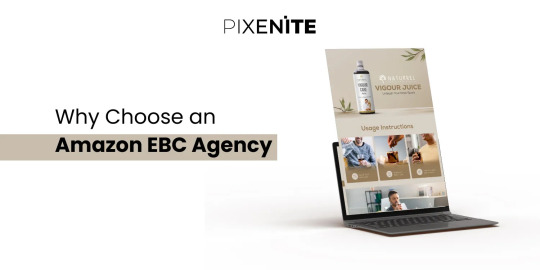
Selling on Amazon is like having a store in a giant mall, but with millions of visitors! Standing out from the crowd is tough. This is where fancy product descriptions and pictures on Amazon (called EBC for short) come in.
EBC is like having a fancy brochure for your product. It lets you show off great pics, explain what makes your product awesome, and even tell your brand story. But creating amazing EBC content can be tricky and time-consuming.
This is where an Amazon EBC agency swoops in to save the day!
Why EBC Matters
Think of your product listing as your shop window on Amazon. EBC helps you make it eye-catching and informative. Here’s how it helps:
More Sales: Great pics and clear descriptions convince more shoppers to buy your stuff.
Brand Power: You can tell your product story and why your product rocks.
Happy Customers: People know exactly what they’re buying, leading to fewer returns.
Top of the Search: EBC can help your product rank higher in Amazon searches.
Stand Out: Make your product shine compared to competitors with boring listings.
Why Partner with an EBC Agency like Pixenite?
Making killer EBC content takes practice in writing, design, and knowing the latest Amazon rules. An EBC agency has a team of experts who can create awesome content quickly.
The A-Team: We have skilled writers and designers who know how to make EBC content sing.
Content Champs: We develop a plan to create content that speaks directly to your ideal customers.
Testing Time: We test different versions of your EBC to see what works best.
Amazon Insiders: We stay up-to-date on all the latest Amazon rules to keep your content rocking.
Growing with You: As your business expands, we can easily scale up your EBC content creation.
Finding the Right EBC Agency
Picking the right agency is key to getting the most out of your EBC investment. Here’s what to look for:
Experience: Find an agency like ours with a history of creating successful EBC content.
Show Me the Money: See examples of work done to make sure it matches your brand style and who you’re selling to.
Amazon Smarties: Make sure they know the ins and outs of Amazon’s platform and how to play by the rules.
Talk it Out: Choose an agency like ours that communicates clearly and works with you to achieve your goals.
Conclusion
Selling on Amazon is a fantastic opportunity, but standing out requires grabbing attention. EBC is a powerful tool to showcase your product’s best features and tell your brand story. Partnering with a skilled Amazon EBC agency like Pixenite can help you create high-performing EBC content that gets results. With engaging content, you can convince more shoppers to choose your product and build lasting success on Amazon!
FAQ’s
Q. What are the different types of EBC things I can use?
There are different types of EBC modules, like text boxes, picture boxes, charts to compare your product to others, and even video! Each type helps you show off a different part of your product.
Q. Is EBC free?
Nope, creating EBC content costs some money upfront. But the extra sales and happy customers you get from it can make it totally worth it!
Q. How do I know if my EBC is working?
Amazon has special tools that let you see how well your EBC is doing. This includes things like how many people buy your product after seeing your EBC, how many people click on your listing, and how many times your product shows up in searches.
Article Source : https://medium.com/@pixenite/why-choose-an-amazon-ebc-agency-acdf1cc908d0
0 notes
Text
Tips for Clients Selecting the Right Web Development Agency
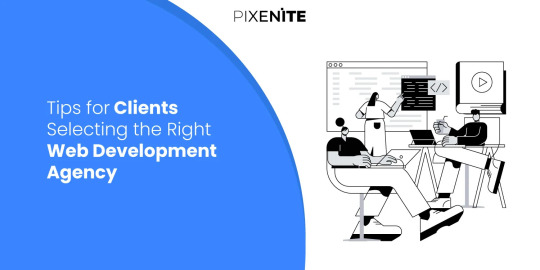
In today’s digital world, it’s really important for businesses to be active online. A well-designed and functional website acts as your digital storefront, attracting new customers and showcasing your brand. But building a website requires expertise — that’s where a web development agency comes in.
Web development agency is a team of skilled professionals who specialize in creating websites. They handle everything from design and development to functionality and maintenance. With lots of agencies around, finding the right one might seem hard. But worry not! This guide will equip you with the essential tips to find the perfect web development agency for your business needs.
Know Your Needs Before You Begin
Before diving into your agency search, take a step back and define your website goals. What kind of website do you need? An informative brochure site? An e-commerce platform to sell products directly? A blog to share industry insights? Knowing your website’s purpose will guide your agency selection process.
Crafting a Clear Vision
Once you understand your website’s objective, it’s time to envision its look and feel. Consider the user experience (UX): how users will navigate and interact with your site. Will it be mobile-friendly? What kind of content will it feature? Jot down your ideas and desired functionalities to communicate your vision effectively to potential agencies.
Researching Potential Agencies
With a clear website vision in mind, start researching web development agencies. Look for agencies with experience in your industry or with websites similar to your desired outcome. Here are some key aspects to consider:
Portfolio: A strong portfolio is a web development agency’s best advertisement. Look for agencies that have created websites you admire in terms of design, functionality, and user experience.
Client Reviews and Testimonials: What do past clients say about their experience with the agency? Positive testimonials indicate a history of satisfied customers and successful projects.
Services Offered: Does the agency provide what you need? This may include web design, development, content management system (CMS) implementation, search engine optimization (SEO), and ongoing maintenance.
Communication is Key
During your research, prioritize agencies that emphasize clear communication. Look for agencies that take the time to understand your business goals and vision before diving into proposals. Here are some ways to assess an agency’s communication style:
Website Content: Does the agency’s website offer clear information about their services and processes?
Initial Contact: When you reach out to the agency, how quickly and professionally do they respond?
Project Management Approach: Does the agency outline a clear plan for communication and collaboration throughout the project?
Budget Considerations
Web development costs can vary depending on the complexity of your project and the agency’s experience level. Be upfront about your budget during your initial conversations with agencies. Reputable agencies will work with you to create a website that meets your needs within your budget constraints.
Don’t Be Afraid to Ask Questions
A good web development agency will be happy to answer any questions you may have. Don’t hesitate to ask about their experience, design process, project timelines, and pricing structure. The more informed you are, the more confident you’ll be in making the right decision.
Building a Strong Partnership
The ideal web development agency is more than just a service provider; they are a partner in your digital success. Look for an agency that aligns with your company culture and values open communication and collaboration.
Conclusion
Choosing the right web development agency is an investment in your business’s future. By following these tips and conducting thorough research, you’ll be well on your way to finding a partner who can create a website that reflects your brand, drives results, and helps you achieve your online goals. Consider reaching out to Pixenite today to discuss your website development needs and see how we can help you build a website that gets results.
FAQs
Q: How much does it cost to hire a web development agency?
The cost of hiring a web development agency can vary depending on the complexity of your project, the agency’s experience level, and the location. It’s always best to discuss your budget with potential agencies to get a customized quote.
Q: What is an ideal timeline to create a website?
The time it takes to make a website can change depending on how big and complicated the project is. However, most agencies will be able to provide you with an estimated timeline after discussing your specific needs.
Q: What should I do after I choose a web development agency?
Once you’ve chosen a web development agency, it’s important to maintain open communication throughout the project. Provide clear feedback and collaborate with the agency to ensure the final product meets your expectations.
Article Source : https://medium.com/@pixenite/tips-for-clients-selecting-the-right-web-development-agency-a633354c210d
0 notes
Text
Tips for Clients Selecting the Right Web Development Agency
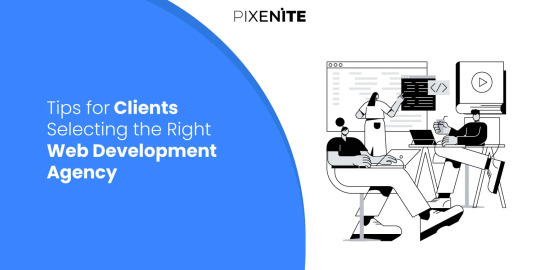
In today’s digital world, it’s really important for businesses to be active online. A well-designed and functional website acts as your digital storefront, attracting new customers and showcasing your brand. But building a website requires expertise — that’s where a web development agency comes in.
Web development agency is a team of skilled professionals who specialize in creating websites. They handle everything from design and development to functionality and maintenance. With lots of agencies around, finding the right one might seem hard. But worry not! This guide will equip you with the essential tips to find the perfect web development agency for your business needs.
Know Your Needs Before You Begin
Before diving into your agency search, take a step back and define your website goals. What kind of website do you need? An informative brochure site? An e-commerce platform to sell products directly? A blog to share industry insights? Knowing your website’s purpose will guide your agency selection process.
Crafting a Clear Vision
Once you understand your website’s objective, it’s time to envision its look and feel. Consider the user experience (UX): how users will navigate and interact with your site. Will it be mobile-friendly? What kind of content will it feature? Jot down your ideas and desired functionalities to communicate your vision effectively to potential agencies.
Researching Potential Agencies
With a clear website vision in mind, start researching web development agencies. Look for agencies with experience in your industry or with websites similar to your desired outcome. Here are some key aspects to consider:
Portfolio: A strong portfolio is a web development agency’s best advertisement. Look for agencies that have created websites you admire in terms of design, functionality, and user experience.
Client Reviews and Testimonials: What do past clients say about their experience with the agency? Positive testimonials indicate a history of satisfied customers and successful projects.
Services Offered: Does the agency provide what you need? This may include web design, development, content management system (CMS) implementation, search engine optimization (SEO), and ongoing maintenance.
Communication is Key
During your research, prioritize agencies that emphasize clear communication. Look for agencies that take the time to understand your business goals and vision before diving into proposals. Here are some ways to assess an agency’s communication style:
Website Content: Does the agency’s website offer clear information about their services and processes?
Initial Contact: When you reach out to the agency, how quickly and professionally do they respond?
Project Management Approach: Does the agency outline a clear plan for communication and collaboration throughout the project?
Budget Considerations
Web development costs can vary depending on the complexity of your project and the agency’s experience level. Be upfront about your budget during your initial conversations with agencies. Reputable agencies will work with you to create a website that meets your needs within your budget constraints.
Don’t Be Afraid to Ask Questions
A good web development agency will be happy to answer any questions you may have. Don’t hesitate to ask about their experience, design process, project timelines, and pricing structure. The more informed you are, the more confident you’ll be in making the right decision.
Building a Strong Partnership
The ideal web development agency is more than just a service provider; they are a partner in your digital success. Look for an agency that aligns with your company culture and values open communication and collaboration.
Conclusion
Choosing the right web development agency is an investment in your business’s future. By following these tips and conducting thorough research, you’ll be well on your way to finding a partner who can create a website that reflects your brand, drives results, and helps you achieve your online goals. Consider reaching out to Pixenite today to discuss your website development needs and see how we can help you build a website that gets results.
FAQs
Q: How much does it cost to hire a web development agency?
The cost of hiring a web development agency can vary depending on the complexity of your project, the agency’s experience level, and the location. It’s always best to discuss your budget with potential agencies to get a customized quote.
Q: What is an ideal timeline to create a website?
The time it takes to make a website can change depending on how big and complicated the project is. However, most agencies will be able to provide you with an estimated timeline after discussing your specific needs.
Q: What should I do after I choose a web development agency?
Once you’ve chosen a web development agency, it’s important to maintain open communication throughout the project. Provide clear feedback and collaborate with the agency to ensure the final product meets your expectations.
Article Source : https://medium.com/@pixenite/tips-for-clients-selecting-the-right-web-development-agency-a633354c210d
0 notes
Text
4 Ways to Make Your Products Stand Out in Amazon Searches
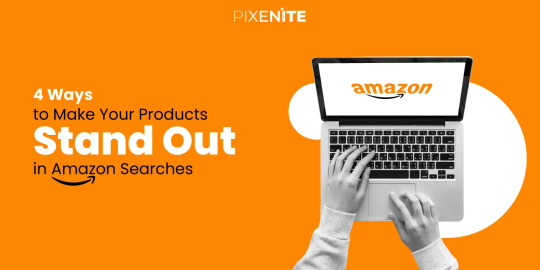
Feeling lost in the Amazon jungle of products? Don’t worry, sellers! Even with millions of competing items, yours can stand out and roar with sales.
This guide explores four simple tricks to make your Amazon listings shine and attract happy customers. Let’s jump in and watch your sales climb the charts!
Trick 1: Talk Like Your Customers
Imagine shoppers whispering what they’re looking for on Amazon. What words would they use? Those are your magic keywords! Tools like Amazon Seller Central and Google Trends can help you discover these keywords.
Here’s the magic: sprinkle these keywords throughout your listing — title, bullet points, and description. But remember, don’t overdo it!
Trick 2: Make a Great First Impression
Your product listing is like your shop window on Amazon. Make it clear, simple, and eye-catching!
Headline Hero: Keep your product title short and sweet (under 200 characters). Include keywords, your brand name, and key features (e.g., “Travel Mug: Insulated, Leakproof, Keeps Coffee Hot”).
Bullet Point Power: Highlight your product’s strengths in short, clear points that focus on benefits. Don’t just list features; explain how they solve problems (e.g., “Keeps drinks hot for hours” instead of “Double-walled insulation”).
Description Dazzler: Craft a captivating description that tells your product’s story. Use simple language, showcase unique features, and include high-quality pictures from different angles.
Trick 3: Reviews are Like Gold
Positive reviews are like gold on Amazon! They build trust, encourage purchases, and boost your product’s search ranking. Here’s how to grow a garden of reviews:
Happy Customers = Happy Reviews: Focus on providing high-quality products that meet (or exceed!) customer expectations.
Politely Ask for Reviews: After a purchase, kindly ask customers to leave a review. Offer straightforward guidance on how to accomplish this.
Respond to All Reviews: Show you care by responding to all reviews, good and bad. Thank happy reviewers and address concerns raised in negative reviews professionally.
Trick 4: Stand Out with Ads (Optional)
While organic search is powerful, consider adding Amazon Sponsored Products Ads. These targeted ads put your product in front of potential customers actively searching for relevant terms.
Targeted Reach: Show your product to shoppers most likely to be interested in it.
Boost Visibility: Paid ads can put your product at the top of search results, increasing its visibility and attracting more customers.
Tip: Start small with Amazon Ads and experiment with different targeting options and budgets to find what works best for your product.
Conclusion:
These small tricks can work like magic to transform your Amazon product listings into dazzling salespeople. If you are still confused about how to do it the right way, well Pixenite can help to create catchy listing images. Contact us today for all your Media Rich Content needs.
FAQ’s
Q: How often should I update my listings?
Regularly review your listings and update keywords based on what customers are searching for and what your competitors are doing.
Q: Is there a word limit for descriptions?
No strict limit, but aim for short and sweet. Most sellers find descriptions between 200–500 words work best.
Q: Any other ways to improve my listings?
Consider offering competitive pricing, fast and free shipping (through Amazon FBA if possible), and bundling products to create attractive deals.
Article Source : https://medium.com/@pixenite/4-ways-to-make-your-products-stand-out-in-amazon-searches-1d42dd4aea52
0 notes
Text
Is Amazon FBA a Good Investment? Things to Think About
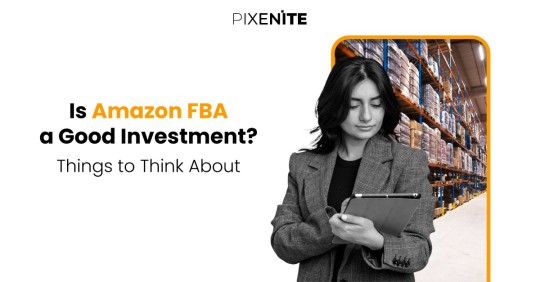
Pixenite is here to help you navigate the exciting world of e-commerce! Today, we're diving deep into a popular option for online sellers: Fulfillment by Amazon (FBA). But before you jump in, let's unpack the details and see if FBA aligns with your business goals.
What is Amazon FBA?
Imagine this: you sell amazing handcrafted pottery on your online store. An order pops up, but instead of rushing to package and ship it yourself, Amazon handles everything! FBA stores your products in their warehouses, picks and packs them when someone orders, and even delivers them to your customer's doorstep. It's a hands-off approach to fulfillment, freeing you up to focus on creating, marketing, and growing your business.
Why Consider It?
There are several reasons why FBA might be a perfect fit for your online business:
Reach tons of people: Millions search for products on Amazon! FBA puts your stuff right in front of them.
Say goodbye to packing boxes! Amazon handles the shipping headaches, freeing up your time to focus on finding awesome products to sell.
Happy Prime members, happy you! FBA sellers can offer Prime shipping, a big plus for many shoppers.
Growing pains? No problem! As your business booms, FBA scales with you. No need to rent your own warehouse!
Trust factor: FBA fulfillment shows customers you're serious. People trust Amazon, and that trust rubs off on you!
Things to Keep in Mind:
Fees: There are costs for storage, shipping, and picking & packing. Make sure you factor these into your prices.
Standing out in a crowd: The Amazon marketplace is packed with sellers. You'll need good marketing and a unique product to get noticed.
Keeping track of your stock: Running out of stock hurts sales. You need to be good at guessing how much stuff to keep on hand.
Less control: Once your products are in Amazon's warehouses, you have less say in how they're packed and shipped.
Product Restrictions: Not all products are eligible for FBA. Check Amazon's guidelines to ensure your offerings qualify.
Is FBA Right for You?
Here are some signs that FBA could be a good fit:
You're selling lighter, non-perishable products.
You don't have the space or resources for storage and fulfillment.
You want to leverage Amazon's vast customer base and fast shipping options.
You're comfortable with some upfront investment in inventory and fees.
If you're unsure, start small! List a few products on FBA and see how it goes. You can always adjust your strategy as you learn more.
Final Thoughts
Whether you choose FBA or decide to fulfill orders yourself, Pixenite is here to support your e-commerce journey! By carefully considering the pros, cons, and your unique business needs, you can make an informed decision about FBA and pave the way for success on Amazon. Remember, there's no one-size-fits-all answer. The key is to choose the fulfillment method that best aligns with your resources, goals, and overall strategy.
FAQ:
Q. Can I sell on Amazon without FBA?
Absolutely! You can fulfill orders yourself, but it requires more time and effort on your end.
Q. How much does the FBA cost?
Fees vary based on product size, weight, and storage time. Use Amazon's FBA fee calculator for estimates.
Q. What are the benefits of FBA for customers?
FBA often translates to faster, free shipping, a major perk for online shoppers.
Article Source : https://www.pixenite.com/how-to-leverage-customer-reviews-on-amazon/
0 notes
Text
How To Leverage Customer Reviews On Amazon?

Customer reviews are the lifeblood of the Amazon marketplace. They’re not just whispers in the wind; they’re booming testimonials that can make or break your product’s success. Imagine them as a chorus of satisfied customers singing your praises, influencing countless potential buyers to join the party. Hire services of marketplace management services for best presentation of your product and boost sales.
The Power Of A Good Review
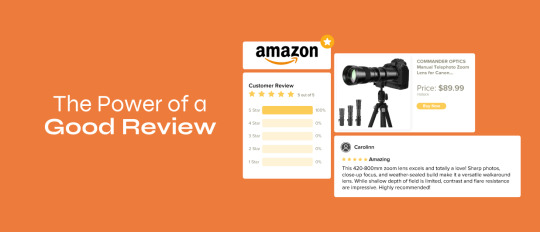
Why are good reviews so important? Here’s a breakdown of their magic touch:
Building Trust: In the digital age, trust is paramount. Positive reviews act as social proof, assuring potential buyers that your product is legitimate and delivers on its promises. Think of them as glowing recommendations from friends, instantly boosting your product’s credibility.
Influencing Decisions: Customers are bombarded with choices. Positive reviews, filled with specific details and genuine enthusiasm, can tip the scales in your favor. They showcase the real-life benefits your product offers, convincing potential buyers to take the plunge and hit “Add to Cart.”
Boosting Search Rankings: Amazon’s A10 algorithm, the secret sauce behind product search results, heavily factors in customer reviews. Positive reviews, especially those with relevant keywords, can significantly improve your product’s ranking. The higher you rank, the more visible you become, leading to a surge in organic traffic and potential sales.
Key Strategies

Now, how can you leverage these customer voices to your advantage? Here’s a deeper dive into some key strategies:
1. Embrace The Review Rain:
Welcome the Sunshine: Positive reviews are pure gold. They highlight what customers love about your product, its unique features, and the value it brings to their lives. These glowing endorsements not only boost your product’s credibility but also influence buying decisions for countless potential customers.
Weathering the Storm: Negative reviews, while they might sting a bit, are valuable opportunities for growth. They might point to flaws you weren’t aware of or areas where your product description could be clearer.
Here’s the key: Address valid concerns promptly and professionally. Apologize for any shortcomings and outline how you’re working to improve – this showcases your commitment to customer satisfaction and can turn a negative experience into a positive display of care.
2. The Gentle Art Of The Request:
Planting the Seeds: There’s no harm in politely requesting reviews from satisfied customers. However, timing is crucial! Don’t bombard them right after purchase. Instead, send a follow-up email a week or two later, thanking them for their business and gently nudging them to leave a review if they’ve had a positive experience.
Remember: Don’t incentivize reviews with discounts or gifts – Amazon strictly prohibits that!
3. Respond Like A Rockstar:
Show You Care: Take the time to respond to reviews, both positive and negative. This demonstrates that you value customer feedback and are actively engaged with your audience. Here’s how to shine:
For Positive Reviews: Thank happy customers for their feedback and acknowledge compliments. You can even personalize your response by mentioning a specific detail from their review.
For Negative Reviews: Apologize for any shortcomings and outline how you’re addressing the issue. This shows you’re committed to improvement and haven’t swept their concerns under the rug.
4. Harness The Review Powerhouse:
Reviews are a treasure trove of information, not just feel-good stories. Use them to identify trends and make data-driven decisions:
Spotlighting the Stars: Are there recurring compliments about a specific feature? Highlight it in your product description! This emphasizes what truly resonates with your customers.
Addressing the Weaknesses: Do negative reviews point to a consistent issue? This is your chance to shine! Take action to address it and elevate your product’s quality. This could involve anything from revising product information to improving functionality.
5. Social Proof Power Play:
Positive reviews act as social proof, building trust with potential buyers who might be hesitant about online purchases. It’s like having a crowd of friends vouching for your product! Here’s how to leverage this effect:
Social Media Symphony: Share snippets from positive reviews across your social media platforms or website. Let others see the real-life experiences of happy customers and how your product has positively impacted their lives.
Website Showcase: Consider dedicating a section on your website to showcase positive customer reviews. This adds credibility and gives potential buyers another opportunity to connect with the voices of your satisfied customers.
By implementing these strategies, you can transform customer reviews from passive comments into a powerful marketing tool that fuels sales and propels your Amazon success. Remember, happy customers are your best advocates, and their voices hold immense power in the vast Amazon landscape. Leverage them wisely, and watch your business flourish!
6. Building A Review Generation Habit
Here are some ways to make it a habit:
Automated Follow-Up Emails: Set up automated email sequences that trigger a review request a few days after a purchase. Keep the email polite and informative, reminding them about their experience and the value of their feedback.
Post-Purchase Inserts: Include a friendly reminder card with your product encouraging customers to leave a review. You can even offer a non-monetary incentive, like early access to new product updates, for leaving a review.
Proactive Customer Service: If a customer reaches out with a positive experience, express your gratitude and gently nudge them to share their feedback in a review.
Turn the Tide of Customer Reviews in your Favor with Us
Ready to supercharge your Amazon strategy? Pixenite offers a comprehensive suite of services, including Amazon Listing Optimization, Enhanced Brand Content Creation, and Data-Driven Marketing Solutions. We’ll help you harness the power of customer reviews and turn your Amazon business into a sales powerhouse. Contact Pixenite today and let’s work together to elevate your brand!
Article Source : https://www.pixenite.com/how-to-leverage-customer-reviews-on-amazon/
0 notes
Text
Social Media Tactics for eCommerce Growth
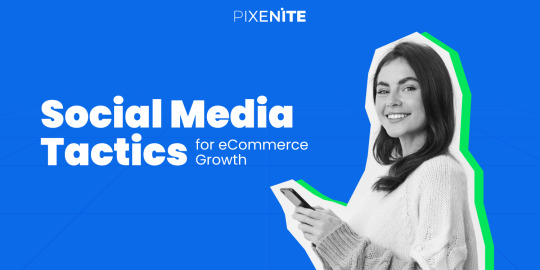
Imagine this: thousands of potential customers scrolling through social media, just waiting to discover your amazing products. That’s the power of social media for your online store! Here’s how to use it to grow beyond.
Finding Your Fans
Not all social media platforms are created equal. Consider where your target audience spends time on the internet. Do they love pretty pictures (Instagram)? Funny videos (YouTube)? Sharing news (Facebook)? Pick the places where they’re already having fun, and join the party!
Content that Keeps People Scrolling
Now for the fun part: creating awesome content! Here’s the secret sauce:
Eye-Catching Photos & Videos: People love pretty things! Show off your products with high-quality photos and short, engaging videos.
More Than Just Selling: Don’t just talk about yourself all the time. Share interesting tips, fun facts, or even take people behind the scenes of your business.
Tell Stories: People connect with stories. Show how your products make life better, solve problems, or create unforgettable experiences.
Let Your Customers Shine: Encourage people to share photos and videos using your products (with a cool hashtag!). This builds trust and shows others how awesome your stuff is in real life.
Go Live!: Jump on live video to answer questions, show off new products, or just chat with your fans. It is the best way to connect instantly.
Make Your Profile Pop
Think of your social media profiles as your online storefront window. Here’s how to make them shine:
Clear Bio: Write a short, sweet bio that tells people what you sell and why they should care. Include a website link so they can easily find you.
Brand Match: Keep your look consistent across all platforms. Use the same logo, colors, and fonts to make your brand instantly recognizable.
Captions that Captivate: Write captions that are interesting, informative, and make people want to chat. Ask questions, run contests, and reply to comments to keep the conversation flowing.
Hashtag Hero: Use relevant hashtags to help people find you. Check out popular hashtags in your area and use a mix of broad and specific ones.
Boost with Paid Ads
Sometimes, you gotta give things a little push. Paid advertising on social media can help you reach a wider audience and target specific groups of people who might love your products.
Laser-Focused Ads: Reach the perfect customers by creating targeted ads based on their interests and online behavior.
Get More Engagement: Boost the reach of your best organic posts with paid advertising. This can spread brand awareness and drive more traffic to your website.
Building Your Online Crew
Social media is all about building relationships with your fans. Here are some ways to create a community that loves you:
Contests & Giveaways: Who doesn’t love free stuff? Organize contests and giveaways to spark interest and encourage conversations about your brand.
Reply Like a Champ: Always respond to comments and messages. Let your audience know you’re listening to their feedback and questions.
Polls & Surveys: Get your audience involved by asking questions and running polls. This helps you understand what they like and tailor your content accordingly.
Listen Up!: There’s a whole conversation happening online about your niche. Use social listening tools to track what people are saying and adapt your strategy to fit their needs.
Remember: Building a strong online community takes time. Be patient, keep creating great content, and show your fans some love.
Bonus Tip: Track your results! See what’s working and what’s not, and use that info to keep improving your social media game.
Conclusion
Feeling overwhelmed? No worries! Pixenite, an eCommerce marketing agency, can help online businesses like yours dominate social media. Our team of experts can create a winning strategy, manage your accounts, and track your results so you can focus on running your awesome business. Let Pixenite take care of the social media hustle while you focus on what you do best: selling amazing products!
FAQs
Q: How often should I post on social media?
A: There’s no one-size-fits-all answer, but it’s important to be consistent. Aim for a few high-quality posts per week on each platform you choose.
Q: What if I don’t have time to create all this content?
A: Repurpose content! Take a great blog post and turn it into bite-sized social media snippets. There are also many free and paid tools to help you create engaging content.
Q: I’m still not sure where to start.
A: Start by picking one platform and focus on doing it well. Research your target audience and see where they hang out online. Once you feel comfortable, you can expand to other platforms.
Article Source : https://medium.com/@pixenite/social-media-tactics-for-ecommerce-growth-cd7bc4b96649
0 notes
Text
Why Low Amazon ACOS is Bad for Amazon Sellers?
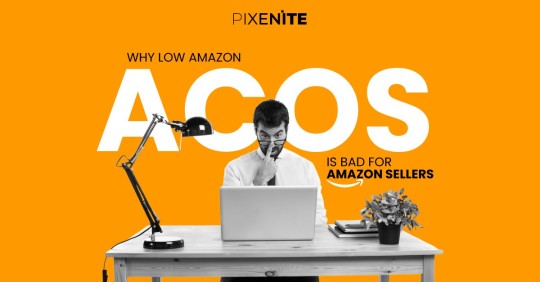
Every Amazon seller dreams of a low ACoS (Advertising Cost of Sale). It signifies efficient campaigns, a healthy return on investment, and a path to profitability. But hold on a minute! While a low ACoS is generally a good thing, it's not always the ultimate goal. Let's delve deeper into the world of ACoS and understand why, in some cases, a slightly higher ACoS might be exactly what you need.
What is Amazon ACoS?
Imagine you spend $20 on advertising and it generates $100 in sales. Your ACoS would be 20%. This metric essentially tells you how much advertising expense it takes to generate a single dollar of sales. So, a lower ACoS means you're spending less on ads to achieve the same sales volume.
How to Calculate Amazon ACoS?
The formula is pretty straightforward:
ACoS (%) = (Advertising Cost) / (Total Sales from Ads) x 100
So, if you spent $50 on ads and generated $150 in sales from those ads, your ACoS would be (50 / 150) x 100 = 33.33%.
What a Good ACoS on Amazon?
There's no magic number for a "good" ACoS. It depends on your product's profit margin, competition level, and advertising goals. Generally, a lower ACoS is desired, but it shouldn't come at the expense of other crucial aspects.
A Low ACoS Isn't the Only Factor
While a low ACoS is certainly desirable, it shouldn't be your sole focus. Here's why:
Limited Growth: Obsessively chasing a rock-bottom ACoS might restrict your ability to expand your reach. By being overly cautious with ad spend, you could miss out on potential customers who might be reached with slightly higher bids.
Reaching New Customers: Sometimes, reaching new customers requires more targeted advertising, which can lead to a higher ACoS initially. However, the long-term benefit of acquiring loyal customers can outweigh the short-term cost.
Testing and Optimization: Constantly testing different ad strategies and keywords is essential for optimizing your campaigns. This testing might lead to temporary fluctuations in ACoS, but the learnings gained can ultimately lead to a more efficient and profitable strategy.
Why Having a Higher ACoS Could Be Necessary?
Here are some scenarios where a higher ACoS might actually benefit you:
New Product Launch: When launching a new product, it's crucial to generate awareness and build brand recognition. A higher ACoS during this initial phase can help increase product visibility and drive traffic to your listing.
Competitive Market: In highly competitive categories, you might need to invest more in advertising to get your product seen. A higher ACoS could be the price of admission to reach your target audience effectively.
Seasonal Products: For products with seasonal spikes in demand, a temporary increase in ACoS can ensure you're capturing those peak sales windows.
Conclusion :
While a low ACoS is generally a positive sign, it shouldn't be your only metric of success. Consider your overall business goals and advertising strategy. Sometimes, a strategically higher ACoS can be a stepping stone to achieve long-term success.
Optimizing your ACoS requires careful analysis, strategic decision-making, and ongoing campaign management. Consider partnering with an experienced Amazon PPC agency like Pixenite (we can help!). Our team can help you develop an effective advertising strategy that balances a healthy ACoS with your broader business objectives.
FAQs
Q. How can I improve my ACoS?
There are lots of ways! Research keywords, make your product listings amazing, use the right "negative keywords" to avoid bad searches, and try different ad designs.
Q. Should I always aim for the lowest possible ACoS?
No, it entirely depends on the situation. Consider your profit margin, advertising goals, and overall business strategy to determine the ideal ACoS for your situation.
Q. How can I track my ACoS?
You can easily track your ACoS within the Amazon Seller Central advertising dashboard.
By understanding the nuances of ACoS and taking a holistic approach to your advertising strategy, you can unlock greater success on the Amazon marketplace.
Article Source : https://www.linkedin.com/pulse/why-low-amazon-acos-bad-sellers-pixeniteofficial-qdqjc/
0 notes
Text
Bad User Experience Is Draining Your Conversion Funnel: How To Fix It?
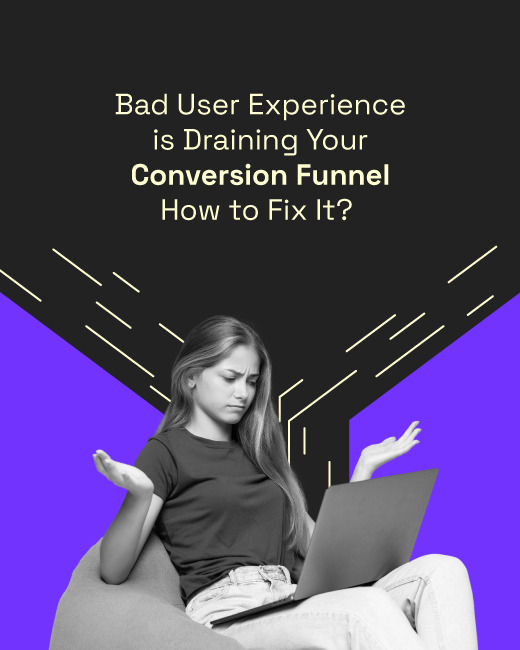
Have you ever gotten super excited about a product online, only to get to the website and completely lose your enthusiasm? Maybe the site took forever to load, the navigation was a confusing maze, or you just couldn’t find the information you needed. Frustrating, right?
That’s exactly what happens when a website suffers from bad User Experience (UX). UX is all about how easy and enjoyable it is for someone to use your website. Think of it like a store: a well-designed website is like a bright, organized store with friendly staff to help you find what you need. A website with bad UX is like a dark, cluttered store with hidden aisles and grumpy employees – you just want to get out!
Here’s the scary part: bad UX is a conversion killer. Conversions are those magical moments when a visitor to your website takes a desired action, like buying a product, signing up for a newsletter, or downloading an ebook. But if your website is frustrating to use, those conversions dry up faster than a puddle in the desert sun. But the good news is that you can always take help from a reputable UI UX Design Agency to avoid such a deadly mistake.
How Does Bad UX Kill Your Conversion Funnel?

Let’s break down the conversion funnel and see where UX cracks can cause major leaks:
Top Of The Funnel (Awareness)
This is where people first discover your website. Maybe they saw an ad or heard about your product from a friend. They arrive curious, but if your website is slow, confusing, or full of flashing ads, they’ll bounce away before even giving you a chance. It’s like walking into a store with the lights out – you can’t see anything and you just leave.
Middle Of The Funnel (Consideration)
Now people are a little more interested. They want to learn more about what you offer. But if your navigation is a confusing labyrinth, your content is full of jargon, or there are no clear calls to action telling them what to do next, they’ll get lost and frustrated. Imagine being in a store with overflowing shelves and no staff – you have no idea where to find what you need and give up.
Bottom Of The Funnel (Decision)
This is where people are ready to convert – buy your product, sign up for your service, or download your ebook. But if your checkout process is complex and confusing, there are hidden fees, or the security seems sketchy, they’ll abandon their cart faster than you can say “lost sale.” Think of being at the checkout line in a store, only to find out the credit card machine is broken – you just leave your stuff and go elsewhere!
How To Fix Bad UX?

The good news? Fixing bad UX is totally doable! Alway rely on experienced and expert UI UX design services as they know what will make the website flawless and soothing to user experience. But if you want to do it yourself then here are some easy ways to patch up those leaks and keep your conversion funnel flowing smoothly:
Clean and Clear Design: Your website should be like a well-organized store – easy to navigate with clear sections and labels. People shouldn’t have to hunt for what they need.
Speed is King (and Queen): Nobody likes waiting in a slow line at the store. Make sure your website loads quickly – every second counts!
Content that Converts: Your website content should be clear, concise, and informative. Answer your visitors’ questions and use strong calls to action to guide them towards conversion. Think of helpful store staff who can answer your questions and point you in the right direction.
Mobile-Friendly Matters: More and more people are browsing websites on their phones. Make sure your website looks good and functions flawlessly on all devices.
Final Words
Is your website frustrating visitors and draining your sales? Pixenite can be your UI UX Design Agency! We’ll transform your website into a conversion machine with a user experience that’s smooth sailing. Imagine your website as a dream store – easy to navigate, lightning fast, and with clear information that guides visitors effortlessly. We’ll make sure it looks fantastic on all devices, especially phones, because that’s how people browse these days. Don’t let bad UX design hold you back – contact Pixenite today! Let’s turn those website headaches into happy conversions!
Article Source : https://www.pixenite.com/bad-user-experience-is-draining-your-conversion-funnel-how-to-fix-it/
0 notes
Text
How influencer marketing can help to grow your business?

Ever feel like your ads are getting lost in the noise? You’re not alone. These days, people trust their friends (online or off) more than fancy commercials. That’s where influencer marketing comes in.
Influencer marketing is like having a popular kid at school talk up your brand to all their friends. These “influencers” are people with big followings on social media who your ideal customer listens to. By working with them, you can tap into their audience and grow your business.
How influencer marketing can help your business? Let’s break it down:
Ever feel like your ads are getting lost in the noise? You’re not alone. These days, people trust their friends (online or off) more than fancy commercials. That’s where influencer marketing comes in.
Influencer marketing is like having a popular kid at school talk up your brand to all their friends. These “influencers” are people with big followings on social media who your ideal customer listens to. By working with them, you can tap into their audience and grow your business.
How influencer marketing can help your business? Let’s break it down:
Get More People to Know You: Imagine showing your product to an influencer followers! Influencers help spread the word about your brand to a whole new group of potential customers who might not have heard of you before.
Build Trust: People trust their favorite online personalities. When an influencer likes your stuff, it makes others trust you more too. It’s like getting a good recommendation from a friend.
Boost Sales: Influencers can show off your product in a fun and interesting way, making people want to buy it. They can even offer special discounts or deals to their followers, which can lead to more sales for you.
Get People Talking: Influencers are good at creating exciting content. By working with them, you can get people talking about your brand online, which is great for free advertising.
Learn What People Want: Influencers can give you clues about what your ideal customer likes and dislikes. This can help you make better products and marketing messages in the future.
Finding the Perfect Influencers:
Not just any social media star will do. Here’s what to look for:
The Right Audience: Find influencers whose followers match your ideal customer.
Lots of Interaction: Make sure the influencer’s followers actually chat and like their posts, not just follow silently.
Great Content: Partner with someone who creates content people enjoy watching or reading.
A Good Fit: Choose someone who’s online personality aligns with your brand’s image.
Conclusion:
Get More People to Know You: Imagine showing your product to an influencer followers! Influencers help spread the word about your brand to a whole new group of potential customers who might not have heard of you before.
Build Trust: People trust their favorite online personalities. When an influencer likes your stuff, it makes others trust you more too. It’s like getting a good recommendation from a friend.
Boost Sales: Influencers can show off your product in a fun and interesting way, making people want to buy it. They can even offer special discounts or deals to their followers, which can lead to more sales for you.
Get People Talking: Influencers are good at creating exciting content. By working with them, you can get people talking about your brand online, which is great for free advertising.
Learn What People Want: Influencers can give you clues about what your ideal customer likes and dislikes. This can help you make better products and marketing messages in the future.
Finding the Perfect Influencers:
Not just any social media star will do. Here’s what to look for:
The Right Audience: Find influencers whose followers match your ideal customer.
Lots of Interaction: Make sure the influencer’s followers actually chat and like their posts, not just follow silently.
Great Content: Partner with someone who creates content people enjoy watching or reading.
A Good Fit: Choose someone who’s online personality aligns with your brand’s image.
Conclusion:
Influencer marketing can really boost your business. By working with the right people, you can reach new audiences, build trust, and ultimately grow your sales. So, why not give it a try? You might be surprised at the results!
Need Help?
Influencer marketing can seem complicated, but it doesn’t have to be. There are companies called influencer marketing agencies, like Pixenite, that can help you navigate the process. They can assist you in finding the right influencer for your brand, develop a targeted campaign, and track your results to ensure success.
FAQs
Q. How much does it cost?
Prices vary, but it depends on how popular the influencer is and what you want them to do.
Q. How do I know it’s working?
Keep track of how many people see the influencer’s posts and how many sales you make after they mention your brand.
Q. What can go wrong?
Sometimes, you might pick the wrong influencer, or your campaign might not be clear. But with a little planning, you can avoid these mistakes.
Q. What are the ways to measure the success of my influencer marketing campaign?
There are a number of metrics you can track to measure the success of your influencer marketing campaign, such as website traffic, brand mentions, social media engagement, and sales conversions.
Q. What are some common influencer marketing mistakes?
Some common mistakes include partnering with the wrong influencers, not setting clear campaign objectives, and failing to track results.
Article Source : https://www.linkedin.com/pulse/how-influencer-marketing-can-help-grow-your-business-s2cuf/
0 notes
Text
How A+ Listings Impact Your Amazon Sales
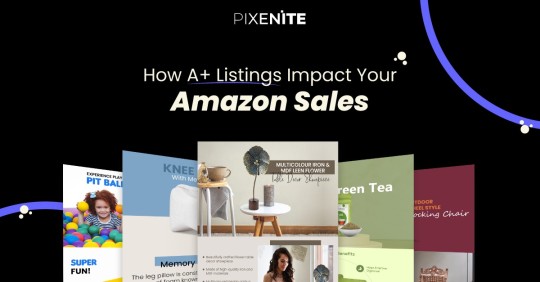
In today's competitive online marketplace, standing out from the crowd is crucial for Amazon sellers. High-quality product listings are your storefront window, and they need to be informative, engaging, and persuasive to convert viewers into buyers. This is where Amazon A+ Listings come in.
What are Amazon A+ Listings?
Amazon A+ Listings (formerly Enhanced Brand Content) is a powerful tool for registered brand owners on Amazon. It allows you to create visually rich and informative product pages that go beyond the standard product description and bullet points.
Here's what you can include in an A+ Listing:
High-quality images: Showcase your product from multiple angles, including lifestyle shots that demonstrate its use in real-world scenarios.
Enhanced descriptions: Go beyond the basic 2,000-character limit and provide detailed information about your product's features and benefits.
Comparison charts: Help customers understand how your product stacks up against the competition.
Brand story: Connect with your audience by sharing your brand's mission, values, and what makes your products unique.
Videos: Bring your product to life with engaging product demonstration videos.
The Benefits of Using A+ Listings
Increased Sales: Studies by Amazon suggest that A+ Listings can increase sales. This is because A+ Listings provide a more immersive and informative shopping experience, making it easier for customers to understand the value proposition of your product.
Improved Conversion Rates: A+ Listings can significantly improve your click-through rates and conversion rates. By capturing attention with high-quality visuals and clear messaging, you can entice customers to learn more about your product and ultimately add it to their cart.
Enhanced Brand Storytelling: A+ Listings allow you to go beyond just selling a product and tell your brand story. You can connect with customers on an emotional level by showcasing your brand's values and what makes you unique.
Reduced Customer Returns: A+ Listings can help to reduce customer returns by providing clear and comprehensive information about your product. This leads to fewer misunderstandings and ensures customers receive exactly what they expect.
Improved Search Ranking: While not explicitly confirmed by Amazon, some sellers report that A+ Listings may improve your product's search ranking within the platform. This is likely because A+ Listings often include relevant keywords that can be picked up by Amazon's search algorithms.
Getting Started with A+ Listings
To create A+ Listings, you'll need to be registered with Amazon Brand Registry. Once enrolled, you can access the A+ Content Manager tool through Seller Central. The tool offers a user-friendly interface with drag-and-drop functionality to create compelling product pages.
Here are some tips for creating effective A+ Listings:
Focus on high-quality visuals: Invest in professional product photography and lifestyle images.
Write clear and concise copy: Highlight the key features and benefits of your product in a way that is easy to understand.
Use strong calls to action: Encourage customers to learn more or add your product to their cart.
Target relevant keywords: Use keywords that customers are likely to search for when looking for products like yours.
Conclusion
By leveraging Amazon A+ Listings, you can create a more engaging and informative shopping experience for your customers. This can lead to increased sales, improved brand awareness, and a more competitive edge in the Amazon marketplace.
Pixenite can help you develop a comprehensive Amazon strategy that includes creating high-impact A+ Listings. We have a team of experienced designers and copywriters who can help you showcase your products in the best possible light.
FAQs
Q. Do A+ Listings cost anything?
A+ Listings are free to use for registered brand owners on Amazon. However, you may incur costs for professional photography, video production, and image creation.
Q. Can I create A+ Listings for all my products?
Yes, you can create A+ Listings for any product enrolled in the Amazon Brand Registry program.
Q. How long does it take to create an A+ Listing?
The time it takes to create an A+ Listing will vary depending on the complexity of your design. However, with a little planning, you can create professional-looking A+ Listings in a relatively short amount of time.
Article Source : https://www.linkedin.com/pulse/how-listings-impact-your-amazon-sales-pixeniteofficial-ufkef/?trackingId=0d8YzdzdGekcJkq2MYE9uA%3D%3D
0 notes
Text
Conquering The Amazon Marketplace: A Comprehensive Guide To Amazon Ads
Amazon PPC

Ever feel like your products are getting lost in the vast Amazon jungle? Don’t worry, you’re not alone. With millions of sellers vying for customer attention, it’s easy for fantastic products to get buried in search results. Think of Amazon Ads like a magic filter. They help cut through the clutter and show your products to exactly the right people – those most likely to buy them.
Should You Embrace Digital Advertising?
Before diving headfirst into the world of Amazon Ads, consider your goals. Are you a new seller looking to establish brand recognition? Or a seasoned pro aiming to boost sales of specific products? Amazon Ads can benefit both scenarios. Here’s why:
Increased Visibility: Shoppers rely heavily on search results to find products. Ads ensure your offerings appear at the top of relevant searches, giving you a prime position to capture attention.
Targeted Marketing: Gone are the days of generic advertising. Amazon Ads let you target specific demographics and interests, ensuring your message reaches the most receptive audience.
Measurable Results: Forget guesswork. Amazon Ads provide detailed reports that track clicks, conversions, and return on ad spend (ROAS). This allows you to optimize campaigns for maximum effectiveness.
Amazon Ad Types

Amazon offers a diverse advertising toolkit, each with its own strengths:
Sponsored Products: The bread and butter of Amazon Ads. These ads appear in search results and product detail pages, showcasing individual products alongside relevant keywords. They operate on a pay-per-click (PPC) model, meaning you only pay when someone clicks your ad.
Sponsored Brands: Ideal for building brand awareness. Sponsored Brand ads showcase your brand logo and a custom message, appearing at the top of search results or product category pages. This strategy is particularly effective for established brands or those launching new product lines.
Sponsored Display Ads: Reach potential customers beyond Amazon with Sponsored Display Ads. These banner-style ads appear on external websites and apps frequented by your target audience, keeping your brand in sight throughout the customer journey.
Amazon DSP (Demand-Side Platform): For high-volume advertisers, Amazon DSP offers programmatic ad buying. This allows you to target specific audiences across various websites and apps using sophisticated buying strategies.
Identifying Your Advertising Champion

So, which ad format reigns supreme for your needs? Here’s a breakdown to help you choose:
For New Sellers or Product Launches: Sponsored Products are a great starting point. They allow you to target specific keywords and showcase individual products with high conversion potential.
For Established Brands: Combine Sponsored Products with Sponsored Brands. Sponsored Products drive sales, while Sponsored Brands build brand awareness and establish trust.
For Retargeting and Brand Awareness: Sponsored Display Ads excel at keeping your brand visible to potential customers who have previously interacted with your products or brand.
For High-Volume Sellers with Advanced Strategies: If you manage a large product portfolio and have experience with programmatic advertising, explore Amazon DSP.
Getting Started With Amazon Ads: A Step-By-Step Guide

Ready to unleash the power of Amazon Ads? Here’s a roadmap to get you started:
Define Your Goals: What do you hope to achieve with your advertising campaign? Increased sales, brand awareness, or driving traffic to specific product listings? Knowing your goals helps tailor your strategy.
Keyword Research: The foundation of successful Sponsored Product campaigns is keyword research. Identify relevant keywords that potential customers might use to find products like yours. Utilize Amazon’s keyword research tools and consider long-tail keywords (more specific phrases) for better targeting.
Campaign Setup: Head over to Seller Central or Vendor Central and navigate to the Advertising section. Here, you’ll create your campaign, choosing your ad format (e.g., Sponsored Products) and setting a budget.
Targeting Options: Define who will see your ads. You can target by keyword, product category, customer demographics, and even interests. The more specific you are, the more likely you are to reach the right audience.
Bidding Strategies: Decide how much you’re willing to pay for clicks. You can choose manual bidding, where you set a specific bid price per keyword, or utilize automatic bidding strategies that Amazon optimizes based on your goals.
Ad Creation: Craft compelling ad copy that highlights the key benefits of your product and entices users to click. Utilize high-quality product images and clear calls to action.
Monitor and Analyze: Don’t set it and forget it! Regularly monitor your campaign performance using Amazon’s reporting tools. Analyze metrics such as clicks, impressions, conversions, and ACoS (Advertising Cost of Sale) to identify areas for improvement.
Optimizing Your Amazon Ads for Maximum Impact
How To Optimize Your Amazon Ads?
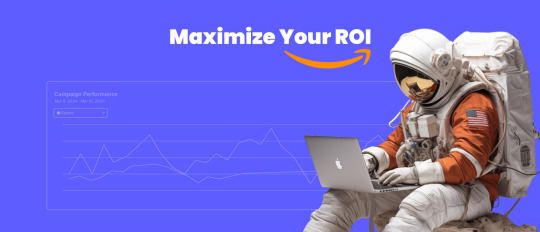
Launching your Amazon Ads campaign is just the first step. To truly conquer the marketplace, you need to continuously refine and optimize your approach. Here are some key strategies:
A/B Testing: Test different ad variations to see which ones perform best. Try out different headlines, product images, and keywords to identify the most effective combinations that resonate with your target audience.
Negative Keywords: Prevent your ads from showing for irrelevant searches by implementing negative keywords. These are keywords that you don’t want your ads to trigger for.
Refine Targeting: As your campaign progresses, analyze your audience data and refine your targeting parameters. Tighten demographics or delve deeper into customer interests to ensure you reach the most qualified buyers.
Landing Page Optimization: Don’t underestimate the power of your product listing. Ensure your product descriptions are clear, concise, and highlight the benefits that resonate with your target audience. High-quality product images and compelling calls to action are also crucial.
Automate Where Possible: Amazon Ads offers a variety of automated tools to streamline campaign management. Consider automatic bidding strategies to optimize your bids based on performance goals.
Stay Informed: The world of Amazon Ads is constantly evolving. Stay updated on the latest features, targeting options, and best practices by reading Amazon’s official resources and attending webinars.
Beyond The Basics: Advanced Amazon Ads Strategies
The vast landscape of Amazon can be daunting, but with the right tools and strategies, you can carve your path to success. Amazon Ads offer a powerful solution to elevate your brand visibility, target the right audience, and ultimately drive sales.
However, navigating the intricacies of campaign creation, optimization, and ongoing management can be a time-consuming endeavor. This is where Pixenite, Amazon Ads Verified Partner steps in as your Amazon Ads guide.
Pixenite, a Amazon PPC agency, understands the unique challenges faced by sellers on the Amazon platform. We offer a comprehensive suite of services designed to help you unlock the full potential of Amazon Ads:
Campaign Development: Our team of experts will collaborate with you to define your goals, identify your target audience, and craft a winning advertising strategy.
Keyword Research and Targeting: We leverage advanced tools and expertise to pinpoint the most relevant keywords and refine your targeting parameters for maximum impact.
Ad Creation and Optimization: From crafting compelling ad copy to A/B testing different variations, Pixenite ensures your ads stand out and resonate with your target audience.
Campaign Management and Reporting: We take the burden off your shoulders by continuously monitoring campaign performance, analyzing data, and making data-driven adjustments to optimize your return on ad spend (ROAS).
Pixenite empowers you to focus on what you do best – creating and selling fantastic products. Let us handle the complexities of Amazon Ads, so you can watch your sales soar and your brand flourish within the Amazon marketplace.
Article Source : https://www.pixenite.com/conquering-the-amazon-marketplace-a-comprehensive-guide-to-amazon-ads/
0 notes